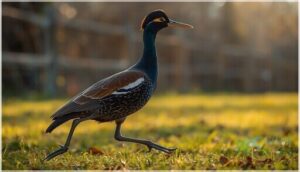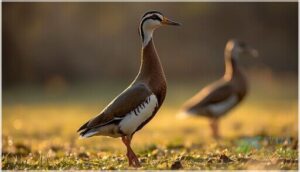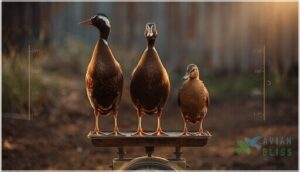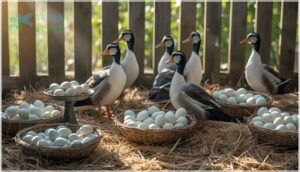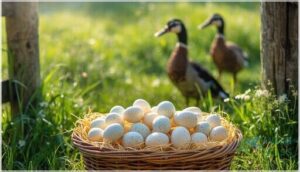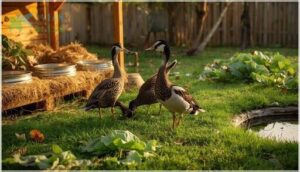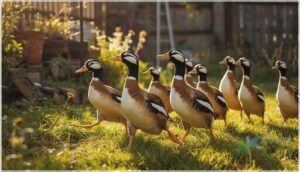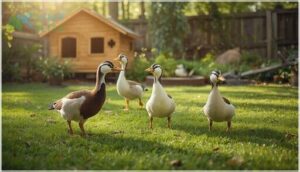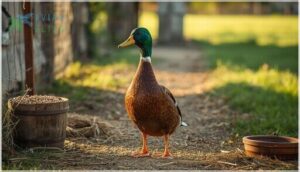This site is supported by our readers. We may earn a commission, at no cost to you, if you purchase through links.

Originally from Southeast Asia, these quirky birds were prized for their ability to pump out 200-300 eggs annually while eating bugs and weeds like living pest control.
Today, they’re beloved by small-scale farmers and backyard enthusiasts who want productive layers without the fuss of chickens. Whether you’re drawn to their comedic waddle, their prolific egg baskets, or their low-maintenance lifestyle, understanding what makes Runners tick will help you decide if these upright oddballs belong in your flock.
Table Of Contents
- Key Takeaways
- Indian Runner Duck History
- Physical Characteristics of Indian Runner Ducks
- Indian Runner Duck Egg Production
- Indian Runner Duck Meat Production and Uses
- Indian Runner Duck Husbandry and Care
- Indian Runner Duck Behavior and Personality
- Keeping Indian Runner Ducks as Pets
- Indian Runner Duck Breeding and Genetics
- Indian Runner Duck Health and Diseases
- Indian Runner Duck Management and Cost
- Frequently Asked Questions (FAQs)
- Do Indian Runner ducks need a pond?
- How much are Indian Runner ducks worth?
- What is the difference between an Indian runner duck and a regular duck?
- Do Indian Runner ducks lay eggs all year?
- What causes lethargy in Indian Runner Ducks?
- How long is incubation for duck eggs?
- Can Indian Runner Ducks swim immediately after hatching?
- What supplements help sick Indian Runner Ducks?
- How to assist an injured Indian Runner Duck to walk?
- Can Indian Runner Ducks fly or migrate?
- Conclusion
Key Takeaways
- Indian Runner ducks deliver 200-300 eggs annually with minimal maintenance, making them one of the most productive backyard layers while also serving as natural pest control through their foraging instincts.
- These upright, penguin-like ducks can’t fly and rarely go broody (under 10% of hens), meaning you’ll handle incubation yourself but never worry about escape artists clearing your fence.
- Keep costs low with just 4-6 square feet of indoor space per duck, $15-20 monthly feed expenses, and their ability to supplement their diet by demolishing garden pests like slugs and insects.
- Plan for a drake-to-hen ratio of 1:5, provide niacin supplementation to prevent leg issues, and expect fertility rates around 75-85% when breeding with proper incubation at 99.5°F for exactly 28 days.
Indian Runner Duck History
Indian Runner Ducks didn’t just appear out of nowhere—they’ve got centuries of history behind them, from ancient temple carvings to modern backyards. These upright, penguin-like birds traveled across continents and were shaped by countless breeders along the way.
Let’s look at where they came from and how they became the quirky ducks we recognize today.
Origins and Evolution
Indian Runner ducks trace their roots back over 2,000 years to Southeast Asia—specifically Indonesia and mainland China—where they descended from wild Mallards and were domesticated before 500 BC. Their evolutionary traits include that signature upright stance and remarkable foraging instinct, shaped by centuries of natural and human-driven selection. The Indian Runner duck’s domestication is closely tied to its balanced diet needs.
- Genetic History: 99.68% DNA similarity across Indonesian breeds
- Ancient Migration: Spread via Dutch trade routes by the 1600s
- Domestication Process: Selective breeding for egg production began early in Java
Ancient Javan Temples and Early Records
Long before the breed had a formal name, Javan temple art at sites like Borobudur captured ducks standing tall—almost penguin-like—dating back 1,000 to 2,000 years. These temple carvings reveal ancient duck breeds central to Indonesian agriculture, herded through rice paddies to control pests.
The Indian Runner duck origin isn’t just folklore; it’s etched in stone. Alfred Russel Wallace even noted their upright waddle in 1856 Lombok, cementing the history of Runner ducks in Southeast Asian history.
The Indian Runner duck breed walked into the historical record centuries before Europe took notice. Indian Runner ducks are known for their unique body shape and distinctive characteristics.
Domestication in India and Indonesia
For over a thousand years, farmers in Indonesia and India shaped what we now call the Indian Runner Duck breed through hands-on selection in rice paddies. You can trace the Indian Runner Duck origin to these regions where duck herding became an art form—flocks of hundreds guided by bamboo poles across flooded fields. This wasn’t just Indonesian Farming or Indian Breeding; it was cultural significance woven into daily life. Duck migration patterns followed seasonal rice farming cycles, and these birds earned their keep through pest control while delivering impressive egg yields.
Key domestication practices that defined Indian Runner Duck characteristics:
- Daily herding routines moved ducks from coops to rice fields each morning after egg collection
- Long-distance walks lasted up to six months to reach Indonesian markets, selecting for stamina
- Integrated rice-duck systems provided natural fertilization and pest management for centuries
- Village-based husbandry kept 95.98% of India’s ducks in rural, backyard settings rather than commercial farms
Your modern Indian Runner Duck care guide owes everything to these traditional methods that prioritized foraging ability and that signature upright posture.
Breeding and Crossbreeding
Those rice paddy pioneers set the stage for modern breeding programs that took Indian Runner Ducks global. Today’s selective breeding focuses on genetic selection for egg machines or meaty birds, with crossbreeding outcomes delivering serious hybrid vigor. Programs like Mojomaster-Agrinak hit 74% annual production, while fertility rates consistently hover between 79–84.5%.
Choosing breeding stock? Here’s your playbook:
- Sexual maturity timing: Selected strains mature at 18–20 weeks versus slower unimproved lines
- Auto-sexing hybrids: Master crosses let you identify male and female ducklings at hatch
- Hatchability sweet spot: Expect 75–80% success rates under proper incubation conditions
- Male-to-female ratios: Maintain 1:5 or 1:6 breeding ratios for ideal fertility rates
Physical Characteristics of Indian Runner Ducks
Indian Runner ducks look like no other breed you’ll come across—seriously, they stand upright like little feathered bowling pins. Their unusual build isn’t just for show, though.
Let’s break down what makes these ducks so distinctive, from their quirky posture to the rainbow of colors they come in.
Unique Body Structure
Picture a wine bottle with legs—that’s your Indian Runner duck. Their skeletal system maintains an upright posture that reaches 45–75 degrees, thanks to body proportions completely unlike other breeds. This Indian Runner duck appearance features a cylindrical frame, tight feather patterns, and legs set way back.
Runner duck characteristics include a running ability that’ll surprise you—these birds sprint rather than waddle, covering ground like feathered athletes.
Stand and Posture
Watch an Indian Runner duck stand at attention, and you’ll witness nature’s rebel. Their vertical posture reaches 45–75 degrees—some even hit 90 when startled.
This upright stance comes from legs positioned way back on their body, creating a penguin-like silhouette that transforms waddling into sprinting. That body orientation isn’t just show; it’s functional freedom, letting your Runners bolt across terrain with leg alignment built for speed.
Weight and Size Variations
Your Indian Runner duck breed defies cookie-cutter sizing—drakes tip scales at 3.5 to 5 lbs while ducks range 3.1 to 4.4 lbs. These size factors and weight range stem from regional variations and growth rates that fluctuate wildly.
Body proportions stay lean regardless, prioritizing productivity over bulk. Duck breed characteristics reveal truth: Runners sprint light, keeping Indian Runner Duck appearance aerodynamic for adventure, not the dinner plate.
Color Patterns and Feathers
You’ll spot eight official Runner duck colors and patterns—from Fawn & White to Cumberland Blue—each governed by feather genetics that’ll blow your mind.
The PMEL gene controls melanin synthesis, while molt cycles shift plumage twice yearly, demanding smart plumage care.
Penciling and chevron patterning traits create visual fireworks, while drakes flaunt those signature curly tail feathers that hens can’t rock.
Egg-Laying Abilities
Runner ducks turn your backyard into an egg factory—you’re looking at 180 to 300 eggs per year, with some flocks hitting a wild 90% daily egg yield during peak months.
Their egg production rates stay strong for four to five solid years, churning out medium to large eggs (65–80 grams) in cool blue or white shades.
Zero broodiness means consistent laying cycles.
Indian Runner Duck Egg Production
If you’re thinking about adding Indian Runner ducks to your backyard, you’re probably wondering what kind of egg production you can actually expect. These upright little oddballs are famous for being egg-laying machines, but there’s more to the story than just numbers.
Let’s break down everything from how many eggs they’ll give you to what those eggs look like and how their laying patterns shift over time.
Average Annual Egg Production
Your Indian Runner ducks can pump out anywhere from 180 to 300 eggs per year—seriously impressive for backyard layers. Top-performing flocks with solid feed optimization and breeding strategies even crack 350 eggs annually.
Egg yield factors like daylight, nutrition, and flock health shape these laying patterns, while production trends show these ducks consistently rival heavy-hitters like Khaki Campbells. Their egg-laying abilities make them egg-production rockstars.
Egg Size and Weight
You’ll get eggs weighing 65 to 80 grams from your Indian Runners—that’s about 25% heftier than extra-large chicken eggs. Egg Weight Factors like age and nutrition play into this: first-year layers start lighter, then ramp up as they mature. Shell Quality stays rock-solid, Yolk Size impresses bakers, and Egg Shape stays consistent. These egg-laying abilities make Indian Runner Duck egg production a backyard win.
- First-year eggs run 50–70 grams before full maturity kicks in
- Mature hens deliver 75–90 gram eggs with outstanding Shell Quality
- Egg production peaks with balanced feed and proper calcium
- Laying Patterns stabilize after year one for size consistency
- About 5–6 eggs equal one pound—perfect egg size for cooking
Egg Colors and Patterns
You’ll notice a surprising spectrum of egg shell colors—white, pale green, blue-green, and light gray—all determined by pattern genetics. About 75% of Chocolate Runners start with bluish eggs that shift lighter as shell pigmentation fades through the season. Green egg production comes from dominant genes, while white stays recessive. Each duck lays consistent pastel green eggs once color variation stabilizes.
Your flock’s egg color won’t budge with diet tweaks—it’s all genetics.
| Variety | Common Shell Colors |
|---|---|
| Fawn-and-White | White, pale green |
| Chocolate/Black | Blue-green, sooty gray (early) |
| Mixed Flocks | White, green-tinted |
| Exhibition Strains | Uniform blue-green or white |
Laying Cycles and Decline
Once your Runners find their rhythm, expect daily eggs from ages 1 to 3—that’s peak egg production territory. Most laying hens crank out 180 to 300 eggs annually, hitting about 5 eggs weekly.
After year three, egg-laying abilities taper by roughly 10% yearly as molting cycles and age kick in. Smart flock management with nutrient supplements helps stretch their egg-laying abilities well into year six.
Incubation Period and Mothering Instincts
Now that you’ve watched your Runners churn out eggs like clockwork, let’s talk about what happens when it’s time to hatch. Runner ducks rarely go broody—fewer than 20% ever commit to sitting on their eggs. When mothering instincts do kick in, egg incubation spans 28 days, but hatching success rates hover around 50-75%. Most abandon ducklings post-hatch, so you’ll likely become the foster parent your hatchlings need.
- Temperature matters: Keep incubators at 37.2-37.5°C for best results
- Broodiness factors are minimal: Only 1-2 hens per flock attempt nesting yearly
- Duckling care falls to you: These moms usually ghost their babies within days
Indian Runner Duck Meat Production and Uses
Indian Runner ducks aren’t usually your first choice if you’re raising birds for the table. They’re lean, lightweight, and bred for eggs rather than meat—but that doesn’t mean they’re useless in the kitchen or limited to just one purpose.
Let’s look at what you can realistically expect if you’re considering Indian Runners for meat production or exploring their other surprising uses.
Meat Quality and Flavor
If you’re expecting rich, fatty duck meat, think again—Indian Runner duck has a lean, gamey taste that feels more like wild bird than barnyard.
This dual purpose breed offers firm-textured meat with a pronounced flavor profile, perfect for rustic culinary uses when you want something beyond typical poultry breeds. It’s an adventurous choice for those who appreciate distinctive meat texture and aren’t chasing volume.
Proper duck care enhances quality.
Fat Content and Carcass Yield
Indian Runner Ducks boast a lean profile, with carcass composition typically showing a 65-70% dressing percentage and minimal subcutaneous fat. Fat analysis reveals that their breast meat contains under 2% intramuscular fat, significantly leaner than Pekin breeds.
This fat reduction translates to healthier meat quality but results in lower yields compared to commercial birds. Their active lifestyle and egg-focused genetics contribute to an efficient carcass composition, making them ideal for those prioritizing duck health over bulk.
Feeding and Nutrition for Meat Production
Getting your Indian Runner ducks to peak meat yield requires strategic nutrition. Unlike typical egg-focused layer feed, you’ll want to prioritize growth rates with targeted dietary supplements that balance protein and energy.
Key feeding strategies include:
- Starter phase (0-3 weeks): Use 20-22% protein waterfowl pellets supporting rapid growth
- Grower shift (4-16 weeks): Switch to 15-18% protein feeds for efficient feed conversion
- Forage integration: Supplement with greens and mealworms boosting nutrient requirements naturally
This approach optimizes your Indian Runner duck feeding regimen without overloading their lean frames.
Slaughter Weight and Age
Your Indian Runner duck reaches peak weight between 16–20 weeks, hitting 3.5–5.1 pounds—far from commercial meat breeds, but perfect for backyard processing. Drakes edge out females by about half a pound.
Expect a carcass yield around 55–60% with lean meat quality that’s closer to wild duck flavor.
This duck breed’s slaughter timeline reflects their dual-purpose nature, balancing duck farming economics with practical duck health and slower growth rates.
Racing and Other Uses
Duck racing isn’t just entertainment—it’s a showcase of your Indian Runner Duck’s legendary upright gait and stamina. These birds have raced in events with 400+ contestants, proving their historical significance beyond the coop.
Duck racing showcases the Indian Runner’s legendary upright gait and stamina, with events drawing over 400 contestants and proving their value beyond the coop
But their real economic value shines in pest control: they’ll demolish snails and insects in your garden through natural foraging behavior. Add soil fertilization and integrated pest management to the mix, and you’ve got feathered farmhands practicing duck herding instincts while debugging your backyard.
Indian Runner Duck Husbandry and Care
Taking care of Indian Runner ducks isn’t complicated, but getting a few basics right makes all the difference between stressed birds and happy, productive ones. You’ll need to think about space, food, shelter, health monitoring, and keeping predators at bay.
Let’s break down what these quirky upright ducks actually need to thrive in your backyard.
Space and Roaming Requirements
Your Indian Runner Ducks need room to stretch those penguin-like legs and live their best life. These natural wanderers thrive when they can forage and explore freely—think backyard paradise, not cramped quarters.
Here’s what works:
- Coop Size: 4–6 square feet per duck for nighttime shelter
- Run Space: 20–25 square feet minimum per bird for daytime movement
- Free Range: Up to 100 square feet lets them debug your garden naturally
More space means happier ducks, better Welfare Impact, and less squabbling in the Duck enclosure.
Dietary Needs and Nutrition
Once your Runners have room to roam, you’ll need to fuel those penguin-paced adventures properly. Start ducklings on Duckling Starter with 20–22% protein, then dial it back to prevent angel wing as they grow. Laying hens? Think 16–18% protein plus calcium supplementation—crushed oyster shell works wonders. Drakes don’t need the extra calcium, so skip the layer feed for them.
Let your flock forage for worms and greens—those foraging benefits include natural niacin and amino acids you can’t bottle. Just avoid toxic foods like avocado and citrus.
| Life Stage | Protein Needs |
|---|---|
| Ducklings (0–3 weeks) | 20–22% |
| Growers (4–16 weeks) | 15–17.5% |
| Laying adults | 16–18% + calcium |
Coop Setup and Cleaning
After dialing in your feed game, it’s time to talk coop design—because your Runners deserve a setup that’s as low-maintenance as they’re independent. Aim for at least 4 square feet of floor space per duck indoors, though 6–10 feels downright luxurious. Use absorbent bedding materials like straw or hemp to tackle that 90% moisture in duck waste, and swap it weekly to dodge ammonia buildup. Ventilation control is your secret weapon against mold and respiratory trouble—keep airflow steady. As for cleaning frequency, daily spot-checks and weekly deep cleans make parasite prevention a walk in the park, not a chore.
- Elevated floors or vinyl coverings protect wood from moisture decay
- Generous bedding layers absorb spills and droppings efficiently
- Daily waterer cleaning prevents biofilm and pathogen spread
- Seasonal deep cleans knock out parasites before winter confinement
Health Concerns and Worm Prevention
Once your coop’s dialed in, it’s time to talk worm prevention—because Runners face real threats. With parasites hitting 51% of local ducks and mortality spiking up to 100% in some flocks, you can’t slack on parasite control. Watch for weakness or labored breathing—classic red flags.
Deworm every 21 days until 63 days old, then twice yearly. Add niacin-rich foods and consider natural remedies like diatomaceous earth to keep mites and worms at bay.
Fencing and Protection From Predators
After tackling worms, your next battle is predators—foxes, raccoons, and hawks all see Runners as easy targets. A 3-foot fence works fine since these birds can’t fly, but add hardware cloth along the bottom foot to block diggers.
For bulletproof predator protection, cover your duck enclosures with mesh roofing and bury wire 12 inches deep around the perimeter.
In a fenced-in yard, check for gaps bigger than 2×4 inches—escape prevention starts with tight weaving and solid enclosure ventilation that doesn’t compromise security measures.
Indian Runner Duck Behavior and Personality
If you’ve ever watched Indian Runners waddle across your yard like a tiny penguin parade, you know these ducks bring serious personality to the table.
They’re curious, independent, and downright entertaining—but they’re not your typical backyard bird.
Let’s break down what makes their behavior tick so you know exactly what you’re signing up for.
Temperament and Socialization
Think of Indian Runner duck temperament as a spectrum—most start skittish but mellow beautifully with consistent Human Interaction. Early handling cuts stress behaviors by nearly half, transforming jumpy ducklings into sociable adults.
Your flock’s Social Bonds strengthen in groups of three hens per drake, keeping Flock Dynamics calm and reducing male squabbles by over 200%.
With patient Docile Training and smart Stress Management, you’ll reveal their naturally friendly Indian Runner Duck behavior—curious, playful, and surprisingly attuned to your daily routines.
Flocking and Roaming Behavior
Your Runner ducks move as one feathered brigade, thanks to Group Synchronization that keeps 100% of the flock in the same microhabitat. Their Flock Dynamics shine in groups above eight, where Social Structure forms within weeks and herding success hits 92%. Daily Roaming Patterns cover 1.2 to 2.3 km while foraging behavior drives synchronized sprints up to 40 meters. Free range settings let social behavior and flock behavior thrive—they’ll explore up to a hectare, always returning by dusk.
| Behavior | Key Stats |
|---|---|
| Daily travel | 1.2–2.3 km foraging |
| Flock spacing | 0.4–0.6 m at rest |
| Roaming range | 0.7–1.2 hectares |
Noise Levels and Communication
Your Indian Runner Duck will usually clock in around 65–75 decibels—about as loud as normal conversation. Females do most of the talking, delivering over 80% of the flock’s quacks, while drakes stick to raspy murmurs. Here’s what drives their vocalization patterns:
- Alarm calls: Brief peaks above 75 decibels when startled
- Feeding frenzy: Excited quacking in descending series
- Calm periods: Soft sounds under 55 decibels
- Evening wind-down: Minimal communication styles after dusk
For noise reduction, keep your flock small and space generous.
Training and Taming
You can flip a skittish Indian Runner Duck’s fear response with socialization methods that work. Start handling ducklings within their first 2–3 weeks for best results—taming techniques show 70% less flight behavior when positive reinforcement begins early.
Offer treats like peas through habituation training, and you’ll see approach times drop from 162 seconds to 80 in just three weeks of consistent duck interaction with humans.
Broodiness and Mothering Instincts
Don’t expect your Indian Runner to settle down on a clutch like a barnyard matriarch—fewer than 10% of females show consistent broody behavior each season. These egg-laying champions were bred to produce, not parent. When broody hen instincts do kick in, it’s brief: most abandon nests within two weeks, with egg abandonment rates hitting 50%. Maternal care? Minimal at best. If your Runner does brood, here’s the reality:
- Nesting instincts rarely last the full 28-day incubation period
- Post-hatch maternal care ends within 48 hours for most mothers
- Ducklings need immediate human intervention for survival
- Incubation patterns favor artificial methods over natural brooding
Plan on being the mother duck yourself when caring for Indian Runner ducks.
Keeping Indian Runner Ducks as Pets
If you’re thinking about bringing Indian Runner ducks into your backyard, you’re in for a treat—but there are a few practical things you’ll want to nail down first.
These quirky birds make surprisingly low-maintenance pets, but they do have specific needs regarding space, diet, and daily care. Let’s break down what you need to know to keep your Runners happy and thriving.
Space and Space Requirements
Think of your Runner ducks as tiny marathon runners—they need space to stretch those legs! Your duck coop should offer at least 4–6 square feet per bird indoors for sleeping and egg-laying. But don’t stop there: outdoor enclosures are where the magic happens. Aim for 20–25 square feet per duck in roaming areas to support their active foraging lifestyle.
Here’s a quick breakdown of space allocation:
| Housing Type | Minimum Space | Ideal Space |
|---|---|---|
| Indoor Coop | 4–6 sq ft/duck | 6–10 sq ft/duck |
| Outdoor Run | 10 sq ft/duck | 20–25 sq ft/duck |
| Free-Range Pasture | 100 sq ft/duck | Unlimited |
| Fence Height | 36 inches | 36+ inches |
| Duck House Ceiling | 24 inches | 30+ inches |
Proper coop setup and fencing options prevent escape artists from staging a breakout. Your duck enclosure requirements should include secure housing with good ventilation—these upright birds need headroom, reaching up to 26 inches tall when fully alert!
Diet and Nutrition for Pets
Your Runner ducks deserve a diet that fuels their active lifestyle—think of it as building their personal buffet. Start with commercial duck pellets containing 16–18% protein as your foundation, mixing in wheat and oats for variety. Adult ducks usually munch through 6–8oz of feed daily, plus whatever they forage.
Here’s what balanced diets for pet ducks should include:
- Layer pellets fortified with niacin (40–90mg/kg) to prevent leg issues
- Fresh leafy greens like kale and lettuce for vitamins
- Slugs, worms, and insects for natural protein
- Whole grains and seeds for energy
- Clean water—always available for swallowing food
Niacin supplementation is non-negotiable for Indian Runner Duck Diet and Growth.
Handling and Socialization
Building trust with your Runners begins the moment they hatch. Handling ducklings gently within the first 48 hours can increase their human acceptance by over 70% once they’re grown. Daily hand-feeding for just 15 minutes improves trust responses by 62%, transforming skittish ducks into friendly companions.
Here’s your roadmap for Social Bonding and Fear Reduction:
| Age Stage | Handling Technique | Expected Outcome |
|---|---|---|
| 0-4 weeks | Daily gentle touch + voice cues | 50% reduction in fear behaviors |
| 4-8 weeks | Hand-fed treats (peas, mealworms) | 45% longer voluntary approach time |
| Adult maintenance | Weekly consistent interaction | 40% fewer escape attempts |
| Group training | Reward-based commands (whistle/hand signals) | 75% reliability after 4 weeks |
| Isolation recovery | Add companion + positive reinforcement | 40% decrease in stress behaviors |
The secret to Gentle Handling is moving slowly—abrupt movements double the likelihood of bolting. Group-raised ducks naturally approach humans in about 3 minutes, compared to 8 minutes for isolated birds. Therefore, keep pairs or trios together during socialization.
Trust Building significantly transforms duck behavior. With reward-based training, you’ll achieve 70% response rates to calls and commands. Your flock will learn their names within two weeks, with a 68% success rate. This makes duck interaction with humans feel less like wrangling and more like a partnership. Keep sessions short, stay patient, and watch your Runners evolve from flighty to friendly.
Noise Levels and Neighbors
Your Runners have earned their freedom, but their quacking might test your neighbor relations. Female Indian Runner ducks hit 90 decibels—lawnmower territory—especially during morning routines between 7-9 a.m. Here’s your sound management playbook for backyard poultry harmony:
- Keep your flock under six ducks to minimize noise complaints
- Position coops at least 20 meters from neighbor windows
- Add drakes to balance flock dynamics—males stay under 60 decibels
- Use tree cover or barriers for natural quack reduction, dropping property-line noise by 20 decibels
Strategic planning keeps both ducks and neighbors happy.
Health Concerns and Veterinary Care
Beyond the quack factor, you’ll want to stay ahead of health issues like duck virus hepatitis (90% mortality in unvaccinated ducklings) and parasites—Capillaria worms alone affect 16-29% of flocks.
Daily health checks catch trouble early: watch for discharge, limping, or feather damage.
Find an avian veterinarian before emergencies hit, schedule deworming every three months, and keep vaccinations current. Disease prevention beats treatment every time.
Indian Runner Duck Breeding and Genetics
Breeding Indian Runner ducks isn’t rocket science, but getting the genetics right takes a bit of know-how. Whether you’re aiming to boost egg production, preserve rare color patterns, or just hatch healthy ducklings, understanding the breeding basics makes all the difference.
Let’s walk through what you need to know about setting up breeding programs, managing fertility, and getting those eggs to hatch successfully.
Breeding Programs and Goals
Think of breeding Indian Runner ducks as sculpting your dream flock—you’re not just raising birds; you’re shaping the future. Modern breeding programs zero in on egg optimization, pushing annual outputs toward 300+ eggs through selective breeding and crossbreeding methods that boost hybrid vigor.
Duck breeding stock gets evaluated on everything from upright carriage to laying frequency. Smart breeders balance inbreeding risks with trait refinement, creating healthier, more productive breeding cycles generation after generation.
Genetic Diversity and Selection
Your flock’s genetic variation is like a safety net—populations with observed heterozygosity around 0.56 stay resilient against inbreeding depression.
Selective breeding programs use molecular genetics (SNP markers, microsatellites) to track breed selection while dodging genetic disorders that pop up when bloodlines get too tight.
Smart duck breeding balances trait enhancement with population dynamics, keeping heritability studies front and center so you’re building robustness, not fragility.
Breeding Cycles and Fertility
When it comes to breeding Indian Runner ducks, timing plays a huge role in your success. Most ducks hit sexual maturity around 18–24 weeks, with mating habits peaking during cooler months—usually late winter to early spring. Your drake-to-hen ratio matters too: aim for one drake per five ducks to keep fertility rates strong, generally hovering between 75–89%. Ideal reproductive health means balanced nutrition, minimal stress, and understanding that egg production cycles naturally dip after peak years.
Here’s what drives fertility:
- Breeding seasons align with cooler weather, maximizing egg-laying capacity
- Mating habits intensify in winter, though drakes stay active year-round
- Fertility rates drop if flock dynamics or nutrition fall short
- Reproductive health depends on diet quality and proper drake-to-duck ratios
Egg Fertility and Incubation
Getting fertile Indian Runner duck eggs starts with proper drake-to-hen ratios—aim for one male per five females to achieve that sweet 83–85% fertility rate. You’ll want to candle around day 14 to check for the telltale bullseye pattern.
Incubation runs exactly 28 days. Keep your incubator humming at 99.3–99.6°F with 55% humidity (bump it to 65–80% during lockdown). Turn those eggs at least three times daily until day 25, then let ’em rest for hatching.
Here’s your quick-reference setup:
| Incubation Factor | Ideal Range |
|---|---|
| Temperature | 99.3–99.6°F |
| Humidity (Days 1–25) | 55% |
| Humidity (Days 26–28) | 65–80% |
| Turning Frequency | 3+ times daily |
| Total Incubation | 28 days |
Fresh eggs from unrelated breeding stock hatch best—sometimes hitting 84% success when conditions align perfectly. Don’t store fertile eggs longer than three days before incubating, or you’ll watch those hatch rates nosedive.
Embryo Development and Hatching
Your Indian Runner duck eggs undergo impressive embryo growth during their 28-day incubation journey. Keep temperatures rock-steady at 99.5°F and humidity between 60–65%—these incubation tips directly boost hatching success by nearly 10%.
You’ll spot development stages through candling: veins appear around day seven, air sacs form by day fourteen.
When ducklings finally pip through at day 28, that’s breeding Indian Runner ducks done right—healthy hatchlings ready for duckling care ahead.
Indian Runner Duck Health and Diseases
Indian Runner ducks are hardy birds, but they’re not invincible. Like any livestock, they can run into health problems if you’re not paying attention to the basics.
Let’s walk through the most common issues you’ll face and how to keep your flock in top shape.
Common Health Issues and Prevention
Your Indian Runner ducks face real threats—and knowing them is half the battle. Disease prevention starts with smart nutrition: ducklings need niacin at nearly twice chicken levels to dodge crippling leg deformities. Duck virus hepatitis can wipe out 90% of your young flock, while respiratory care means keeping bedding dry to avoid aspergillosis.
Stay ahead with:
- Vaccination strategies against Duck Viral Enteritis
- Health supplements like brewer’s yeast for nutritional deficiencies
- Strict biosecurity to prevent parasite control nightmares
Parasite Control and Worm Prevention
You can’t afford to let parasites hijack your flock. With infection rates hitting 51% in some regions, parasite detection through fecal testing twice yearly isn’t optional—it’s survival.
Flubenvet remains your gold-standard deworming method, though spot-on ivermectin works for nematodes (1 drop per 500g, three weeks running).
Rotate pastures every 30–90 days and avoid overgrazing below 4 inches. Watch for parasite resistance by monitoring treatment effectiveness. Smart worm prevention beats playing catch-up every time.
Vaccination and Treatment
Protect your flock from avian health disasters—vaccination isn’t negotiable. Duck Viral Enteritis vaccines slash outbreak sizes by 96–99%, while Avian Influenza shots start at 14 days with boosters every 4–6 months. Here’s your battle plan:
- Vaccinate for Duck Viral Enteritis (annual revaccination for breeders)
- Target Avian Influenza at 14 and 28–30 days
- Use Riemerella anatipestifer vaccines at 7–10 days
- Monitor for bacterial infections requiring antimicrobials
- Schedule twice-yearly health checks
Unvaccinated Runner ducks face 80% mortality during outbreaks—those odds stink.
Injury and Trauma Care
When your Runner takes a tumble or gets roughed up by a predator, quick action makes all the difference. Clean wounds with saline immediately, control bleeding, and watch for signs of shock. Head injuries, leg fractures, and soft tissue trauma are common duck health concerns requiring emergency care.
Isolate the injured bird on soft bedding, manage pain, and call your avian vet—especially if mobility or feeding is compromised. Your first aid kit should include saline, gauze, and antibiotic ointment for effective wound management.
Genetic Disorders and Defects
Beyond injuries, you’ll want to watch for inherited traits that can derail your flock’s health. Congenital defects like twisted bills, kinked necks, or awkward leg placement signal chromosomal aberrations that affect duck health concerns long-term.
- Avoid breeding birds with visible deformities or low body carriage
- Watch for white feather patches in black or chocolate ducks—it’s genetic
- Provide proper nutrition to prevent angel wing in ducklings
- Maintain genetic diversity to reduce inherited Indian Runner Duck health issues
Indian Runner Duck Management and Cost
Before you jump into raising Indian Runner ducks, you’ll want to get a clear picture of what you’re actually signing up for financially.
The good news is that these upright little foragers won’t break the bank, but there are still real costs to factor in from day one through their productive years.
Let’s break down what you can expect to spend so there are no surprises down the road.
Initial Investment and Start-Up Costs
Getting started with your Indian Runner Duck flock isn’t a break-the-bank situation, but you’ll want to budget smart. Duck coop construction and setup usually runs $800–$1,000 for materials, while fencing costs another $150–$400 depending on your space.
Ducklings themselves go for $12–$14 each, and equipment expenses—feeders, waterers, and starter feed budget—add roughly $100–$150 upfront. Think of it as startup financing for your feathered freedom fighters!
Ongoing Expenses and Maintenance
Once you’ve set up your flock, ongoing expenses keep your runners thriving. Coop maintenance—replacing straw bedding weekly—runs about $7–$10 per bale. Water costs stay minimal at $5–$12 monthly, though you’ll refresh pools twice weekly.
Health checks and routine worming every 5–6 months cost $3–$8 per duck. Fencing repairs average $50–$150 yearly, while feeding your duck diet right prevents nutritional deficiencies and maintains their health requirements long-term.
Feed and Nutrition Costs
Your wallet won’t take a beating with Indian Runner duck feeding—but smart nutrition planning matters. Here’s what you’re looking at:
- Daily feed costs: Expect $15–20 monthly per duck for commercial layer pellets (16–18% protein) to meet their feeding and nutritional requirements.
- Feed conversion efficiency: These active foragers reduce pellet dependency when free-ranging, boosting cost efficiency naturally.
- Dietary optimization: Supplement with whole grains, greens, and calcium sources during laying cycles for better feed budgeting.
- Annual investment: Budget roughly $180–240 per duck yearly for a balanced diet that keeps production strong.
Duck feeding doesn’t need fancy formulas—just consistency and quality ingredients for ideal nutrition.
Veterinary Care and Health Costs
Duck health emergencies don’t announce themselves—one day your bird’s fine, the next you’re racing to the vet. Here’s your financial roadmap for poultry health:
- Annual basics: Budget $40–50 yearly for routine wellness, disease prevention, and deworming to tackle nutritional deficiencies before they escalate.
- Emergency care: Medical treatment for infections or injuries runs $150–300, with veterinary fees climbing 10% annually.
- Prevention pays: Regular health checks slash long-term costs.
- Health insurance: Rare for ducks, but self-budgeting $200–550 yearly covers surprises.
Egg and Meat Production Costs
Your feed expenses will eat up 70–75% of production costs—that’s the reality. Runner ducks consume 160–180 grams daily during peak egg laying, translating to roughly $0.90–$1.30 per dozen eggs produced. Meat pricing sits at $3–5 per kg, while egg revenue peaks when birds hit 250–350 eggs yearly, netting $12–25 profit per duck in well-managed flocks.
| Cost Factor | Annual Impact |
|---|---|
| Feed expenses | 70–75% of total |
| Labor savings (automated systems) | Cuts input 35% |
| Egg production break-even | 220–260 eggs/year |
| Net profit potential | $12–25 per duck |
Frequently Asked Questions (FAQs)
Do Indian Runner ducks need a pond?
You might think a full pond is essential, but it’s not. Indian Runner ducks thrive with shallow water sources like kiddie pools for bathing needs, duck hygiene, and drinking—no elaborate waterfowl setup required.
How much are Indian Runner ducks worth?
Purchase costs for this upright duck breed range from $13–$19 for ducklings and $10–$20 for adults, with proven breeding pairs commanding $65–$150 based on quality and egg production potential.
What is the difference between an Indian runner duck and a regular duck?
Unlike most domestic ducks that waddle, Indian Runner ducks stand nearly upright like penguins and run instead of walk.
They’re lighter, more active foragers, and produce markedly more eggs annually than typical backyard breeds.
Do Indian Runner ducks lay eggs all year?
Your flock won’t clock out for winter—Runner duck egg production continues year-round in mild climates with adequate light exposure.
Egg laying patterns shift during seasonal fluctuations, temperature influences, and molting, but proper management keeps those egglaying abilities humming strong.
What causes lethargy in Indian Runner Ducks?
Lethargy in your ducks often signals infectious diseases like avian cholera or duck plague, nutrient deficiencies—especially niacin—environmental stress from heat or overcrowding, toxic exposures, or injury trauma requiring immediate attention to restore duck health issues.
How long is incubation for duck eggs?
Most duck eggs hatch around day 28, though Muscovies stretch that timeline to 35 days.
For Indian Runners specifically, you’re looking at the standard 28-day incubation period—assuming your temperature and humidity stay consistent.
Can Indian Runner Ducks swim immediately after hatching?
Yes, ducklings can swim within 24-48 hours of hatching thanks to natural Swimming Instincts and early Duckling Development. However, Feather Waterproofing takes about four weeks to develop, creating significant Hypothermia Risk and Water Safety concerns requiring careful supervision.
What supplements help sick Indian Runner Ducks?
When your duck’s under the weather, Vitamin Therapy and Probiotic Supplements restore gut health, while Electrolyte Balance and niacin combat nutritional deficiencies.
Energy Boosters like glucose solutions support quick Nutrient Recovery during illness.
How to assist an injured Indian Runner Duck to walk?
Ironically, sometimes the best help starts with doing less—gently assess the injury, then focus on wound management and controlled rest.
Water-based physical therapy builds strength without strain. Assistive devices like splints stabilize fractures.
Always consult your vet for serious health issues.
Can Indian Runner Ducks fly or migrate?
These duck breeds can’t get airborne—their wing structure and terrestrial movement adaptations prevent flight patterns. Migration habits? Nonexistent.
Runner duck temperament and behavior keeps them grounded, preferring flocking behavior over wandering, ensuring impressive duck lifespan through Runner duck adaptability and habitat stability.
Conclusion
Think of Indian Runner ducks as the quirky overachievers of the poultry world—they’ll march through your garden like tiny soldiers, devour pests like living Roombas, and drop eggs faster than most chickens without demanding fancy housing or constant attention.
Whether you’re chasing fresh breakfast or just want entertaining yard companions, these upright oddballs deliver performance and personality in one feathered package.
Give them space, water, and decent feed—they’ll handle the rest like pros.
- https://megcooperation.gov.in/duck_farming/Modern_Duck_Farming_Practices.pdf
- https://en.wikipedia.org/wiki/Indian_Runner_duck
- https://www.fresheggsdaily.blog/2025/04/all-about-indian-runner-ducks.html
- https://www.cabidigitallibrary.org/doi/pdf/10.5555/20210513278
- https://livestockconservancy.org/runner-duck/

